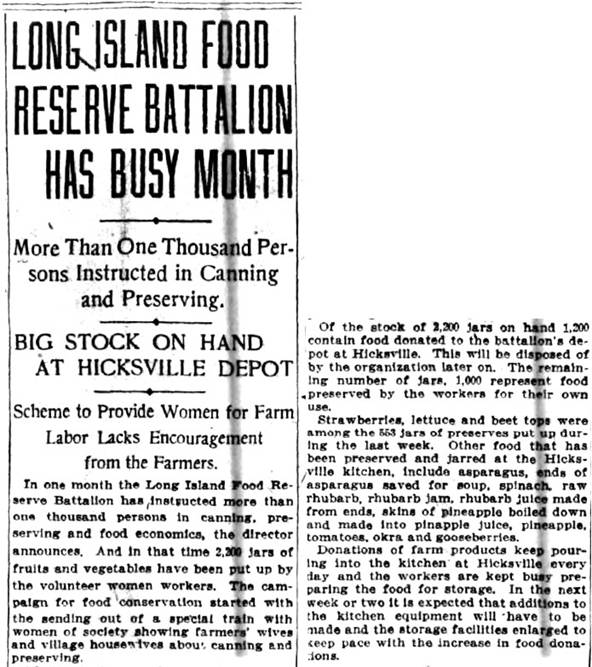Storage Jars Help Make the Difference
Suddenly, things were different - with the country going to war, it needed all the help that women could give. In a story somewhat reminiscent of a Monty Python episode, it was reported that women all over Long Island had been transformed into vital wartime resources, and now were efficiently preserving vast quantities of food in jars, thanks to the Food Reserve Battalion.
New York Herald, July 8, 1917
With women contributing so visibly to the war effort, many men on the home front faced a dilemma. Even if they opposed Prohibition, would their consciences allow them to vote against women's suffrage come November?
Some among them, perhaps less generous in spirit, faced a slightly different version of the same problem. Men were registering for the draft; others were enlisting. Women were already working at various jobs men had vacated. If you lived in a small rural town, and everyone knew that you liked to drink your beer or your liquor once in a while, and women's suffrage was again rejected at the local polls, everybody - "everybody" now being mostly women - was going to start looking at you a lot less kindly, because they pretty much knew that you'd voted against it. Just saying.
*
The Hicksville page of the Long-Islander of October 12, 1917 mentions an upcoming "big suffrage rally in Fireman's Hall." Of greater interest is a separate article on the same page. After receiving a petition signed by nearly 14,000 Nassau County women who could gain the right to vote after the upcoming election, the County Board of Supervisors officially endorsed the proposed amendment to the State Constitution. Two weeks later, enthusiasm ran high as another women's suffrage meeting was held at the Town Hall.
On October 20, the Sea Cliff News reported that many Nassau County women would be taking part in the New York City suffrage parade scheduled for one week later. The report claimed that the parade might well "outstrip" any similar parade previously held anywhere in the United States - and perhaps it did. It was not the showiest suffragist parade ever, but it may have been the most dignified, and it was very suitable for wartime. It took 2½ hours for the 25,000 marchers to pass any given point. The paraders carried the signatures of more than 1,000,000 women who had petitioned for the right to vote.
The thoughtful words below convey very well how things had changed.

excerpt from 25,000 SUFFS WIN CHEERS IN PARADE
The Brooklyn Daily Eagle, October 28, 1917
Most of the excerpt above is clear. For those readers who want to know what Service Flags were, and the significance of the stars they carried, I refer you to one of the first articles in this series: Ancient Hixtory June 2018.
***

